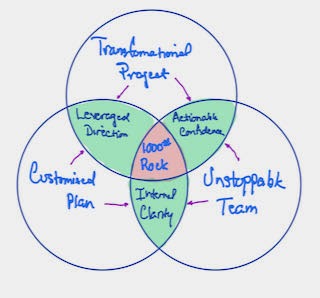
I was speaking with a strategy VP in an international firm who was getting ready to deliver a presentation for the executive team that showed a surprising under performance of projects to the business case benchmarks they had set.
Just for the record, this is a high-quality team with sound leadership, strong values and a deeply held drive for success – as well as a proactive approach to solving problems head on. But, unfortunately, hidden systemic patterns can create shortfalls that will derail even the most capable of teams.
These kinds of metrics present what I call “1,000 pound rock” kinds of issues. These can occur in a variety of ways in business when the impact is large and the approach to breaking things down into solvable pieces is unclear. Thousand pound rocks are real, in plain sight and completely immovable.
In leadership settings, they can make for interesting dialogue, and not uncommonly, a rush to establish “the problem” and a work plan to get “back on track.” While inwardly, with reflection, everyone in the discussion realizes there is a complex system at work, there is intense pressure to get to closure.
Unfortunately, what sometimes happens in sessions, is that a few anecdotes get knitted together into an ad hoc work plan and a task force is formed. The result is that the systemic items that underlie these outcomes tend to be stubborn and outlast the team’s ability to stay focused on them. Many times this leads to project leaders altering the path of the project, leaving these high-leverage items to be addressed by the next group.
The net effect? These items build up, but the metrics adapt to hide them and deeper value remains hidden.
Cracking the 1,000 Pound Rock

Moving forward on this class of problems demands that we do “both and” thinking: we need to use a tool that allows us to examine the challenges both as a whole and as addressable parts.
The key is having a model and language in place that both allows us to make progress on the part, as well as giving us a leveraged result on the whole.
Using a framework places everyone on the diagnosis and solution team, rather than competing to establish a single viewpoint. It unlocks the wisdom of the team to inform the solution.
Over the arc of dozens of strategic engagements with complex firms, as well as my 30+ year career as a Fortune 100 executive, I’ve discovered and honed an applied model that has these characteristics. This is not an academic tool that was built to create a PhD thesis (not that those are bad), but instead uses hard won insight from pick and shovel strategy work under the harsh light of challenging business conditions. It’s a framework that I’ve discovered, taught and applied with dozens of leaders who have successfully used it to establish a path to results in complex and opaque conditions.
Unpacking the Framework
Let’s talk directly about how to approach this using the framework. At the first level of decomposition, there are three vectors that are essential to finding, forming and delivering fresh value. They are:

Leveraged Direction = project + plan: This vector is created from the integration of a project and a plan, that in its most simple description, contains insight. This insight is the product of looking carefully at the data, context and capabilities of the client and the firm. The result is that the group steps above simple task coordination to peer level integration. Most importantly, this allows the team to all get on the same side of the table using the same framework and vocabulary on the solution to the challenge.
- Actionable Confidence = project + team: This vector comes from the combination of the project and a team. It is not uncommon for teams early in this journey to have trouble making decisions that reach implementation – perhaps coming to and then revisiting them, and even sometimes reversing direction. Sometimes with mature teams, they are caught in a perfection loop, always analyzing, never deciding. When we get this right, the group makes crisp investment and decision making that elevates the confidence of the group to take on the high-stakes, irreversible decisions that are frequently needed to deal with stubborn complex issues. When investment of time, money and resources are in line with client need and the firm’s capability, sustained momentum is the result.
- Internal Clarity = plan + team: This comes from the combination of a true team (and not just a group of individuals that is unbonded) and a customized plan. Firms where leadership is done in a matrix (the majority of complex firms) need to have line of sight and structure that builds clarity so that those at the intersection can make clear decisions. This is very important in those members of the firm that provide essential support to teams – critical staff and members of operations and sales whose input is vital and ability to participate is limited. Many times as I’m completing the Phase One internal interviews, I find many of the functional teams have their own version of the plan, with gaps between teams. Once these are clear, and strong lateral connections formed, the effectiveness of the group is elevated dramatically. Having done the work allows your best to work on the most highly-leveraged issues.
The Key: Capabilities in Balance
Back to my conversation with the strategy VP.
To help him best position his presentation for the executive team, I sketched out the simple three-part model above and we began talking about what each of these capabilities looked like. Much like a physical therapist, we talked through the relative strengths and areas of opportunity for their firm. In a few minutes, we had direction and insight of where to apply scarce time, money and attention to make real progress.
The question became a simpler one: Which of these three strategic elements are the strongest? Where is the corresponding opportunity?
Our short conversation helped this leader identify a clear direction and insight regarding resources, but that’s just the starting point. In order to move fully towards higher-value results, it’s helpful to look at the nine accelerators that allow you to identify the right transformational project, develop a custom plan that’s right and cultivate an unstoppable team.
I’ll be sharing more about these 9 accelerators over the coming blog posts, so stay tuned.
What’s the Right Next Step for Your Team?
If you’ve read this far, you’ve probably recognized the need to look at hard problems systematically and begun to do some diagnostic work yourself. If you’d like to have a coffee conversation with me directly on your 1,000 pound rock challenge, please reach out to me via email or use this link to put a discussion on the calendar.
Related Posts:

